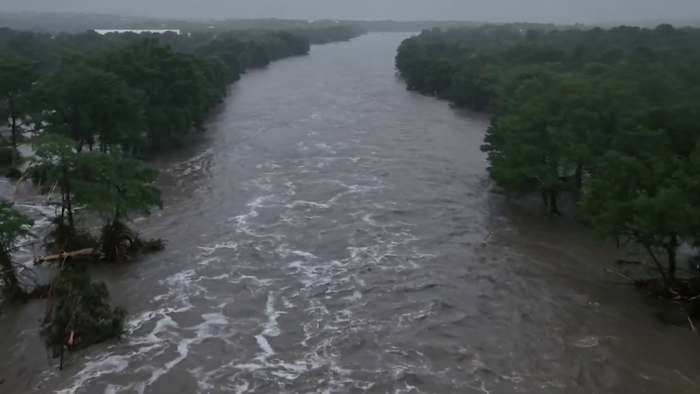STORY HIGHLIGHTS
-
WEIGHT OF WATER: Just one gallon of water weighs eight pounds
-
INCREDIBLE FORCE: The floods created massive amounts of lateral and buoyant forces
-
SPEED: Water was likely flowing 10 to 12 miles per hour, aided by gravity
KERR COUNTY, Texas – “I remember something hitting me in the head,” said Leo Romero Jr., who survived the Kerr County floods. “Next thing I know, the house is gone.”
Romero was one of several survivors who recalled just how powerful the floodwaters truly were.
“We could see my cousin’s house at the base of the hill, and all I saw was water. … Just unbelievable speed,” recalled Bill Washam.
“It was like you were standing under a waterfall, and it was going straight over,” another July 4 survivor, Scott Towery, said. “You couldn’t see anything.”
Survivors of the floods have tried to describe the forces they felt, but it’s tough to put the power of water into words. Water itself weighs more than people realize.
“Just a gallon of water is about eight pounds,” Dr. Chris Combs, an engineering professor at UTSA, said. “A cubic foot of water, which is really about the size of a large beach ball — that’s over 60 pounds right there.”
In the case of Kerr County, there was a wall of water rising more than 30 feet. With that much water moving at a rapid rate, the forces are devastating.
“We had, at some of the worst spots, about a million gallons per second of water flowing through those rivers,” Combs said. “That’s really comparable to what you see going across Niagara Falls, and that works out to around 10 million pounds per second of water moving through. That is like 10 fully loaded 747s. It is just unbelievable amounts of weight moving fast downstream.”
Estimates had the water moving down the Guadalupe River somewhere between 10 to 12 miles per hour, aided by gravity. We know through math equations that only a foot of water can move a car, providing some 500 pounds of force.
“That’s like a routine tackle from an NFL linebacker,” said Combs. “It just takes about six inches of water to sweep a person’s feet out from under them, because that really is, it’s like a person running at full speed hitting you. Hitting you right in the ankles.”
Amazingly, through feats of strength, some survivors, after being swept into the floodwater, were able to hold onto trees.
“I mean, you’d probably be moving around 10 miles per hour. That’s like a hard run, right? And if people aren’t familiar, I say, ‘Go to the gym, hop on a treadmill, set it to 10, and see what that feels like,’” Combs said. “And then imagine trying to jump and grab a tree branch while you’re moving at that speed.”
On top of everything else, there were also massive amounts of debris in the water. Structures along the river were not only destroyed by the lateral force of the river, but also by what’s called buoyant force.
“You’ve got two things kind of working hand in hand. You have that strong lateral force which, like I said, with about a foot of water alone you get about 500 pounds of pushing force on the side,” Combs said. “Then you combine that with, it’s really about 1,500 pounds of upward force for every foot of the water. So, you get things get lifted and they get pushed and then once they get swept off the foundation then that’s just floating away.”
The end result is damage that is reminiscent of other major disasters.
“You get to a certain point. You’re looking at forces that are similar to getting hit by a car or tornado and really some of the damage that we saw after the fact, it does look similar to that type of event,” Combs said.
More related coverage of this story on TheTXLoop.com:
Copyright 2025 by TheTXLoop – All rights reserved.
